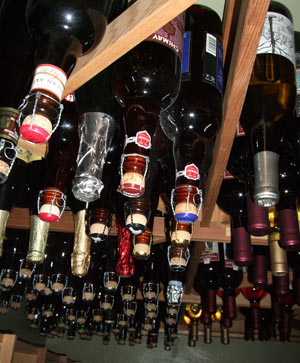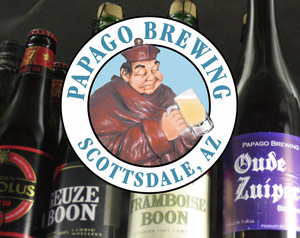SEARCH THIS ISSUE >>> |

Cellaring Beer
This is a 'reprint' of the 'beer education for wine drinkers' article of the same name in the latest issue of Arizona Vines and Wines magazine. This version is basically the same with a few extra notes mixed in. In these short magazine articles there's not enough time to get into too much detail, but I think this serves as a great primer. Anything I say here has been verified over years of cellaring.
“I’m not going to commit infanticide!” With that exclamation my friend Jon made it clear that he would not allow me to open the 7 year old Bordeaux I offered. Since the wine was far too young for his taste, we shared a well-aged beer instead.
When I speak about aging a beer, I want to make it clear that I’m not speaking about most mass-produced, pasteurized, ultra-filtered beers that have thin, simple profiles. Those beers are as good as they will ever be. They are made to drink right now. However, many beers have big bold flavors that will benefit from proper cellaring.
Are you unfamiliar with cellaring beer? Here are some tips to get you started.
Keep it in the dark. Have you ever tried an old “skunky” beer? That smell actually has nothing to do with age and everything to do with exposure to light. In fact, the correct term for that smell is “light struck”. When you buy beer for long term storage you’ll want to consider how it has been stored prior to purchase. A green or clear bottle sitting under bright fluorescent lights might already be ruined before you buy it. A dark brown bottle is much better, but I rarely buy beer that has been in any direct light unless I know it has only been there for a short time.
Note: There is some controversy surrounding the issue of laying bottles down versus storing them upright. I store most of my corked bottles on their sides. This has worked well for me for many years. I've experimented with standing them upright and had some lose pressure due to the extremely dry air when I lived in Phoenix. Even those beers hadn't gone bad, they were just close to flat. I would never lay down capped bottles or bottles with rubber stoppers.
Keep it cool and stable. A cellarable beer is alive and does not enjoy high temperatures or extreme temperature fluctuations any more than you do. A stable cellar temperature between 50-60 degrees will be safe and effective for aging pretty much any beer. Remember that the colder the temperature the slower the beer will develop in the bottle. If you have a beer that is already at the optimal taste for your enjoyment, put it in the refrigerator and enjoy it reasonably soon.
Look for clues. Does the bottle say “best after 2014”? Then you can be pretty sure it’s built to last. Does it say “best before 2014”? Once again, that’s one to age and may even last many years beyond the suggestion. Is the beer bottle conditioned? A bottle conditioned beer is still alive and worth trying. Of course, you can always ask someone who knows.
Have a sense of adventure. There is no way to predict exactly what you’ll get from a beer until you’ve started to experiment. If you buy a few bottles, you’ll be able to see how the beer changes in 6 months, 1, 2, 3 years etcetera.
 If you cellar wine, you’ll notice that richer, bigger beers (Barley Wines, Belgian Strong Ales, Imperial Russian Stouts) can do well at the warmer temperatures that bold reds can handle. But, I’ve found 55° Fahrenheit to be the best number. If you can’t achieve these temperatures in your situation, you may not be able to store a beer for several years. However, you might get up to a few years of safe cellaring (depending on the beer style) if you can keep your storage temperature stable and below 70 degrees.
If you cellar wine, you’ll notice that richer, bigger beers (Barley Wines, Belgian Strong Ales, Imperial Russian Stouts) can do well at the warmer temperatures that bold reds can handle. But, I’ve found 55° Fahrenheit to be the best number. If you can’t achieve these temperatures in your situation, you may not be able to store a beer for several years. However, you might get up to a few years of safe cellaring (depending on the beer style) if you can keep your storage temperature stable and below 70 degrees.
Note: Before building a cellar, I had personally saved many types of beer (mostly big Belgians) for up to 5 years at a constant 71° Fahrenheit with no problems whatsoever. The problem is that 71° is far from a catchall (many types of beer will be ruined) and if you can't guarantee that 71° is the absolute top temperature you're riding on the very edge of losing all your beer. Just a week at 74 degrees can really mess up a great beer. Many Belgian beers can handle some heat, but what's the point of living on the edge like that? If you're going to invest in beer, invest in a home for your beer.
There are many similarities between the ways beer and wine develop over time. Of these, the easiest to understand and apply is the correlation between hop bitterness in beer and (seed, skin and stem) tannins in wine. Just as tannins slowly integrate and soften in wine revealing previously hidden subtleties, so too, hop bitterness integrates, softens and allows flavors that were once hidden to emerge. In storable beers there may also be grain tannins, but these styles of beer are often stored at the brewery for months or years before being released, so the tannins are already significantly softer than in the beginning.
Try buying an American Barleywine like Sierra Nevada’s Bigfoot, Stone’s Old Guardian or Avery’s Hog Heaven and observe how it seems to get bigger and richer over time as the bitterness gets softer. Strong Ales from Belgium have a history of lasting (and improving) through decades in cellars. Many of these beers (including many versions of these beers made in the U.S. and Canada) transform after 3 to 6 years in the bottle, developing a more complex and wine-like structure.
Ron Kloth -beer aficionado and owner of Papago Brewing- has beers of various styles in his personal cellar. He says he loves aging Belgian Lambics and Trappist Ales. The oldest are two 40 year old bottles of Westmalle Tripel & Westmalle Dubbel which he plans to open when they turn 50.
If you want to get started on the right foot in Arizona, I’d recommend a visit to Papago Brewing.
 FEATURED BREWERY
FEATURED BREWERY
Papago Brewing
At Papago Brewing they love beer! They have 30 beers on tap at all times with a constant rotation of their own beers and several others from far and wide. They also have a few hundred rare and interesting varieties you can purchase by the bottle to drink there or to take with you. Ratebeer.com ranked Papago as the 13th best place to drink beer in the world and it’s plain to see why.
Ron creates and tests his recipes at home and then gives the instructions to the brewers so they can reproduce his beers on a large scale. If you would like to take home a Papago beer for aging, try Oude Zuipers. At 11% alcohol, this will keep for several years as the complex fruit and spice notes integrate and the structure develops.
Ron Kloth tried brewing his first beer as a science experiment when he was in elementary school, brewed a few times in college & started to get serious about brewing in 1990. Papago has been open since 2001 & will be bottling and distributing their Orange Blossom Wheat beer this summer. Papago beers are made at two different Arizona breweries and one Belgian brewery.
For more information about Ron Kloth and Papago Brewing see Man of the Kloth also in this issue
--Thomas Ale Johnson
